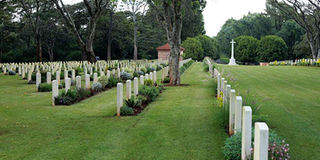In the cemetery where 1,952 war heroes rest

The Nairobi War Cemetery, on January 29,2020. The cemetery serves as a favourite spot for visitors. PHOTO | SILA KIPLAGAT | NATION MEDIA GROUP
What you need to know:
- The Commonwealth Graves Commission has done an impressive job of ensuring the graves are well maintained.
- Despite the risk of being robbed, many people still enjoy visiting the cemetery to see the final resting place of some of Africa’s fallen soldiers.
The Nairobi War Cemetery is situated on Ngong road, 10km outside the bustling central business district.
Within the hushed cemetery grounds, straight, neat rows of white grave markers indicate the final resting place of 1,952 fallen soldiers, who served as British troops in the Second World War.
As visitors enter the cemetery, the usual sounds of construction machines, vehicle horns and motorcycle engines are quickly replaced by calmer sounds of wind blowing and birds chirping from the surrounding Ngong Forest Reserve.
A kilometre-long gravel driveway leads from the entrance of the cemetery to the burial ground.
The Nairobi War Cemetery was set up in 1942 by the British military to serve as the permanent resting place for fallen East African troops.
The cemetery’s location also served as the site for two British general hospitals between 1943 and 1946.
TRIBUTE
From the entrance of the cemetery, visitors can easily spot the large white War Cross that stands on the northern side of the cemetery.
The War Cross is a mandatory religious monument in most Commonwealth war cemeteries across the world. It represents the selfless sacrifices of soldiers, who died serving their countries.
To the south of the cemetery, directly opposite the War Cross, stands the Stone of Remembrance.
Out of the 32 Commonwealth war cemeteries in Kenya, the Nairobi War Cemetery is the only one with a Stone of Remembrance.
Due to the costliness and complexity of the monument, only cemeteries with more than 1,000 graves have a Stone of Remembrance.
The monument is engraved a tribute, "Their name liveth forever more".
All the graves are marked with limestone headstones of the same shape and height. Each headstone lists the soldier’s rank, name, regiment number, date of death and (in some cases) age.
EA MEMORIAL
The Commonwealth War Graves Commission ensures equality by making all the graves identical regardless of the soldier’s rank. Each headstone has at its base a well-groomed bed of indigenous flowers.
The cemetery also demarcates the graves based on religion. The graves of Christian soldiers stand on the north, right next to the War Cross.
The graves of Jewish soldiers are located on the eastern side, while the graves of Hindu soldiers are on the southern side of the cemetery.
The Nairobi War Cemetery also hosts the East Africa Memorial that commemorates East African troops who died, and were buried, in foreign lands.
Some columns bear the names of soldiers of the land forces who died during the British military advance against Italy on the Northern Kenya border between 1939 and 1941.
Other columns bear the names of troops who died at the sinking of SS Khedive Ismail on 12 February 1944.
DAYLIGHT ROBBERY
The steamship was on its way to deliver troops from Mombasa to Sri Lanka (formerly Ceylon) when it was suddenly attacked by a Japanese submarine.
On the day 1,296 people perished, the British troops on board were 996 soldiers from East Africa’s 301st Field Regiment.
The exact number of East Africans who died is not known. It was the largest loss of African soldiers in a single incident. The Nairobi War Cemetery turns 79 this year.
The Commonwealth Graves Commission has done an impressive job of ensuring the graves are well maintained.
Any repairs required on the headstones are done with careful expertise using materials that are often shipped from France.
Even so, the cemetery is plagued by robberies. Security guards at the graveyard are understaffed and poorly equipped to handle the robberies. They ask visitors to be cautious and walk in groups.
Despite the risk of being robbed, many people still enjoy visiting the cemetery to see the final resting place of some of Africa’s fallen soldiers.
The cemetery also serves as a favourite spot for visitors, who simply wish to relax in the silence and beauty of the cemetery.
Is there a site you want us to feature? Write an e-mail to [email protected]




